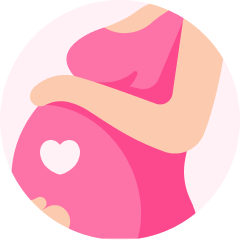What is a Cesarean Section Surgery?
Cesarean section surgery (C-section) is a surgical procedure where a doctor makes an incision in the abdomen and uterus to deliver your baby. Typically, this surgery is performed if there are complications or difficulties with your normal childbirth (vaginal delivery). Additionally, it may be scheduled if you’ve had a previous C-section. If this is your first childbirth, your doctor will consider a C-section only when you’re in labour.

Why is a Cesarean Section Performed?
Sometimes, a C-section is the safest method. Your doctor may recommend surgery in the following cases:
- Your baby is in a breech position (baby’s bottom is down).
- Your baby is not growing well or is weak.
- Placenta previa covers the cervix.
- You have had a previous C-section.
- You are expecting twins or multiples.
- You have complications that make a C-section more suitable for you.
- You have medical conditions such as high blood pressure or diabetes that increase the risk of complications during childbirth.

What are the Risks of Cesarean Section?
C-sections are commonly performed today and are generally safe for both mother and baby. However, like any surgery, it carries some risks. Additionally, the recovery time is longer compared to vaginal delivery. A notable risk is the weakening of the uterine wall due to the incision, which may cause difficulties in subsequent vaginal deliveries, although it’s reassuring that half of women can still safely deliver vaginally in subsequent pregnancies.
Though complications are generally reduced due to recent clinical practices, there are still potential risks involved, including:
- Infection at the surgical site.
- Endometrial infection, causes fever, abdominal pain, abnormal vaginal discharge, or heavy bleeding.
- Blood clots (thrombosis) in the legs, can be dangerous if a clot breaks loose and moves to the lungs.
- Heavy bleeding.
- Injury to the bladder or ureter (the tube connecting the kidneys and bladder), requiring further surgery.
However, recent changes in clinical practices have reduced infection rates. Doctors administer antibiotics before surgery to reduce the risk of infection.
Risk Towards Your Baby
Common issues affecting babies delivered by C-section include respiratory distress, which primarily affects preemies. For babies born after the 39th week via C-section, the risk of respiratory issues significantly decreases to levels similar to vaginal birth.
C-sections neither increase nor decrease the risk of severe complications for the baby, such as nerve damage in the neck or arms, intracranial bleeding, cerebral palsy, or death. Occasionally, a baby’s skin may be nicked while the uterus is being opened. This occurs in 2 out of 100 C-sections but usually heals without harm.
Other than that, babies who were born via cesarean section were also known to be at risk of lower immune systems. This is because a baby born via vaginal delivery is exposed to different microorganisms from the mother’s faecal and vaginal environment when they passed through the birth canal. These microorganisms help them build their immune system and microbiome.
It’s crucial to understand these risks and complications before undergoing this surgery. If you have any questions, consult your doctor or surgeon for further information.

How Do I Prepare for a Cesarean Section Surgery?
C-sections are usually planned. You’ll need to meet with your anesthesiologist to assess your health-related to surgery. Your doctor may check your blood type in case you need a transfusion during surgery. If you’re delivering before 39 weeks, your doctor will conduct tests on your baby’s lungs using amniocentesis to see if they’re mature.
Moreover, be aware that even if you opt for vaginal delivery, you should discuss this surgery with your doctor since, in emergencies, a doctor may switch from vaginal delivery to a C-section.
What Happens During a C-Section?
The surgery typically takes 40 to 50 minutes. Your abdomen will be monitored to record your baby’s birth. The doctor makes a horizontal incision below your abdomen, above the pubic bone. Then, they insert surgical instruments through the incision to make another incision in your uterus. Subsequently, the doctor delivers the baby.
After delivering the baby, the doctor injects oxytocin hormone into you. It can help your uterus contract, reducing bleeding. The placenta and umbilical cord are then cut. The doctor stitches the vaginal and abdominal walls. The stitches may be absorbable or non-absorbable.
If you have any questions or concerns, consult your doctor or surgeon for further information.

What Happens After a Cesarean Section Surgery?
After the surgery, you’ll be taken to the recovery room to wake up from the anaesthesia gradually. Your doctor will closely monitor you during this stage. They may conduct several tests to assess your health status, such as:
- Blood pressure measurement;
- Respiratory rate measurement;
- Oxygen levels in the blood.
You may be given some pain relievers such as paracetamol or NSAIDs, and sometimes stronger analgesics like morphine.
If you have any questions, consult your doctor to understand the best treatment.
[embed-health-tool-bmi]

















